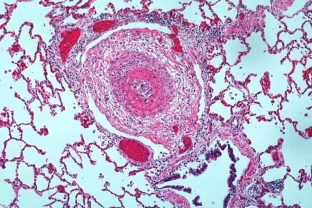Kidney dysfunction is not only one of the most common manifestations of nodular type periarteritis, but also an important symptom from the point of view of making a diagnosis by a doctor. According to some data, kidney damage covers 60-80% of patients, and according to some other sources, all cases of periarteritis nodosa. Signs of impaired renal function in this disease, as a rule, are combined with other clinical symptoms. However, it is quite possible to meet descriptions of polyarteritis, the symptoms of which apply only to this group of lesions.
Manifestations of kidney damage in periarteritis nodosa
In the greatest number of cases, impaired renal function with this diagnosis is manifested by symptoms of primary vascular damage - vasculitis of the internal arteries of the kidneys of medium diameter, as well as the development of renal infarction and ischemia. Only in a small part of patients the glomeruli are affected, as a result of which glomerulonephritis may develop. The classic form of renal reaction to periarteritis nodosa leads to damage to the glomeruli in rather rare cases.
Manifestations of renal pathologies in periarteritis nodosa are detected by several research methods. However, it should be noted that the clinical picture of the disease may appear only 3-6 months after the onset of the disease.
As mentioned above, in most situations, impaired renal function in periarteritis nodosa manifests itself in the primary vascular lesion. It is possible to identify certain signs of this by both macroscopic and light-optical research methods.
Pathomorphology of kidney damage in periarteritis nodosa in different methods:
- The macroscopic appearance of kidney lesions is directly related to the form of the lesion. In total, we can name two such forms: acute and chronic. The size of the kidney changes only in the latter case - they become smaller. However, in both forms, the kidneys have an uneven surface due to the alternation of normal tissue coverage and the affected one. On the incision, outbreaks of aneurysmal enlargements, as well as arterial thrombosis, can also be noticeable. Sometimes aneurysms of the central artery of the kidneys may occur.
- Segmental vasculitis of the internal arteries of the kidneys can be detected by the light-optical method, which is also characterized by the alternation of healthy and disturbed sections of the vessels. In many cases, damage to the walls of blood vessels is also noted. A characteristic disorder in periarteritis nodosa can also be the simultaneous presence of both acute and chronic changes in the vessels.
In the classic form of disorders inherent in periarteritis nodosa, hypergranulation and hyperplasia of cells containing renin are often noted.

Clinical manifestations of kidney disorders in periarteritis nodosa
As for the clinical picture of kidney lesions, it is worth noting that they can appear only after a while (3-6 months). They are reflected in a person's blood pressure, the amount of creatinine in the blood, as well as the filtration function and the appearance of microhematuria.
The main symptoms of kidney damage in periarteritis nodosa:
- Arterial hypertension. It is characterized by a persistent increase in pressure, especially diastolic. The early form of hypertension with the active influence of vasculitis is prone to further development.
- Increased blood creatinine and/or deterioration in glomerular filtration function. These symptoms occur in approximately 75% of patients with this disease.
- Urinary syndrome. In most patients with periarteritis nodosa, it is expressed by mild proteinuria and microhematuria.
It has also been noted that 25% of patients with impaired renal function may develop renal failure. Thus, the detection of impaired renal function should be an indication for a wider examination of the body in order to identify possible systemic diseases that provoked kidney pathology.






Add a comment